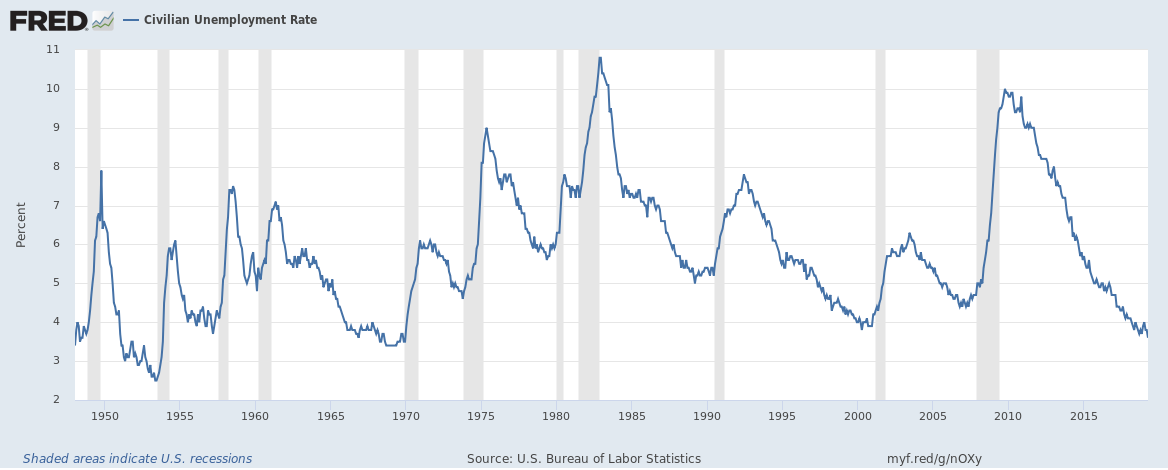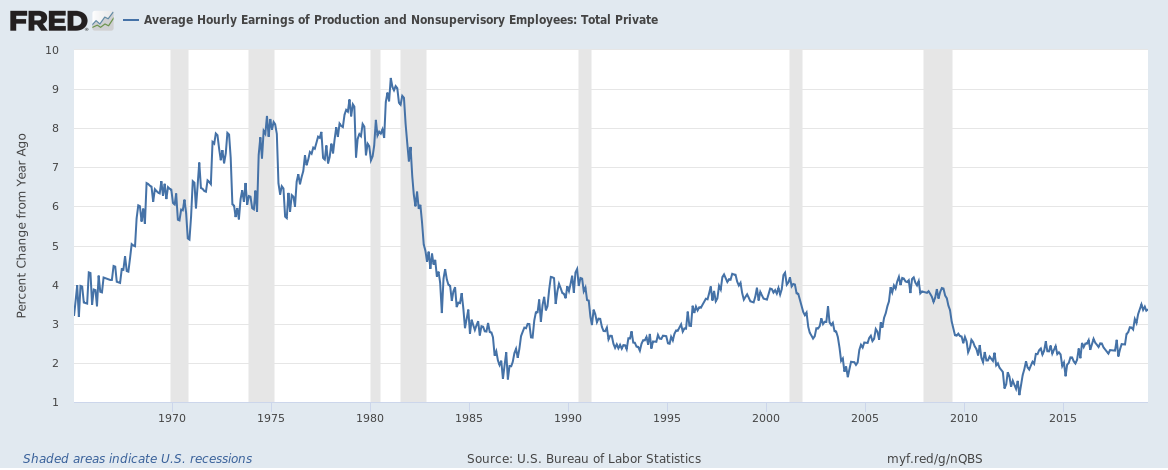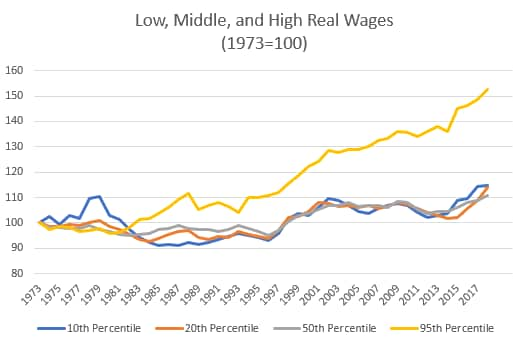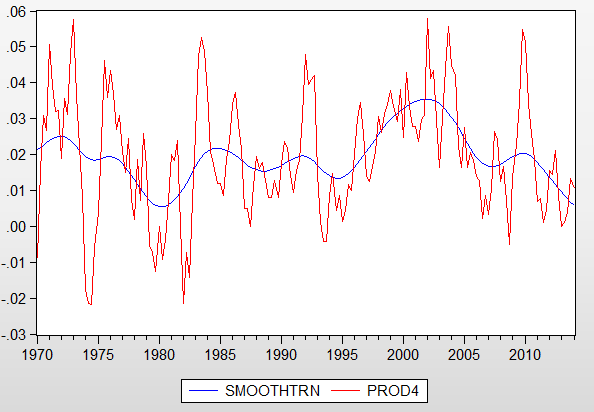Why capitalists hope you have a short memory
The American economy is looking good. But snapshots can be deceiving.


Is American capitalism broken? That question has been percolating through U.S. politics lately, and more and more people are answering in the affirmative. But our economy still has plenty of defenders. And if you take this moment in time as a snapshot, the case for capitalism looks pretty good.
As the American Enterprise Institute's Robert Doar recently noted, wages are rising faster now than at any point since the Great Recession, and they're rising faster for the bottom half of Americans than the top. Productivity growth appears to be returning to its post-WWII average, and Americans making more than $100,000 are a bigger chunk of the population than they've ever been. GDP growth has picked up, and unemployment is shockingly low.
Certainly, the current economy looks good compared to the last few years. But snapshots can be deceiving. Should this one moment be how we judge the health of our economic system? If we gaze back across the last half century or so, the current moment doesn't look as impressive. And even more striking are the deep, frequent ditches U.S. capitalism has driven itself into over the last few decades.
The Week
Escape your echo chamber. Get the facts behind the news, plus analysis from multiple perspectives.

Sign up for The Week's Free Newsletters
From our morning news briefing to a weekly Good News Newsletter, get the best of The Week delivered directly to your inbox.
From our morning news briefing to a weekly Good News Newsletter, get the best of The Week delivered directly to your inbox.
Yes, unemployment is currently below four percent. But the last time that happened was almost two decades ago, in the late 1990s boom. The previous dip below four percent barely lasted a year; the current one has made it about a year and a half. Prior to the late 1990s, unemployment hadn't gotten below that threshold since 1970. Unemployment under four percent would be a testament to American capitalism's virtues if it was a regular occurrence, but not when it's merely a brief tease that comes once every 20 years.

The same goes for wage growth, which did indeed reach a welcome 3.4 percent earlier this year. The thing is, business cycle peaks have usually boasted wage growth of four percent or a bit better. We got there in both the late 1990s before the dot-com bust, and again in 2007 before the Great Recession hit. A decade out from that last collapse, we have yet to get back to that peak. The four percent peak is also just what we've been reaching since 1980 or so. In the decades immediately following World War II, income growth regularly got even higher.

Of course, in between each of those peaks, wage growth dropped precipitously, with the latest fall having ground on for an especially long time.
As you might have guessed by now, the same problem applies to wage growth for less privileged Americans. Wages for the bottom 10 percent (the blue line below), the bottom 20 percent (the orange line) and the bottom 50 percent (the grey line) suddenly picked up a little steam in the last two years or so, after a long period of stagnation. But the last time they did that was, again, for three or four years in the late 1990s boom. In between, wages for these Americans flatlined. And the only time they grew significantly before the late 1990s was all the way back in the late 1970s! The 2007 business cycle peak was so tepid it did nothing for wage growth in the bottom half.
A free daily email with the biggest news stories of the day – and the best features from TheWeek.com

It's also true that wages for the bottom half of Americans have actually grown faster than for the upper half of income earners in the last few years. But if you slice the population more finely, the picture doesn't look so good. The top half as a whole isn't growing all that fast, but if you return to the graph above, wages for the top five percent (the yellow line) have been cruising upward with nary a stumble since the 1980s. Inequality just kept right on increasing.
All of this relates back to productivity growth as well, since it's a key ingredient in rising wages. The causal arrow also goes the other direction, however. As unemployment gets really low, employers have to pay higher wages to attract scarce labor, and that eats into their profit margins. To stay ahead, they have to become more efficient, adapt new technologies, and figure out how to get more value out of their inputs. Low unemployment and high wages drive productivity growth as much as vice versa.
Not surprisingly, the jobs and wages boom of the late 1990s was also a productivity growth boom. As you can see in the graph below, the blue line briefly reaches over three percent in that period. (The red line is the raw productivity growth data from year to year, which as you can see is extremely noisy. The blue line smooths out the trend to make it more readable.) But then the recessions of 2000 and 2008 dragged productivity growth down, and we're only now getting back to two percent. The overall post-war average was also pulled down by a similar collapse around the 1980 recession.

Finally, the economy is also struggling from some deep structural problems in critical areas like child car, health care, housing and education. Doar argues that Americans are better off because things like consumer electronics and household furnishings have gotten cheaper. But his own data also shows that prices for education, health care, and child care have all grown much faster than wages.
Meanwhile, national housing price growth may not be so bad, but it's quite severe in specific areas like big cities. And the job market has rejiggered itself in such a way that most good jobs are now only available in those same places. Thus, even relatively well-off Americans find themselves caught in a loop where wages come in and then go right back out again, with little left over for savings.
There is indeed a lot of churn in Americans' fortunes. "More than half of Americans will be part of the top 10 percent of earners at some point in their lifetimes," as Doar notes. But that's mirrored by the fact that 60 percent of Americans between ages 25 and 60 will spend at least one year in the bottom 20 percent of earners, and 40 percent of them will fall into the bottom 10 percent.
Either capitalism's defenders have short memories, or they're hoping the rest of us do. Because if you take a snapshot of every year going back to World War II, and line all those snapshots up,then the latest snapshot just looks like an inadequate and all-too-brief respite in American capitalism's long decay.
Jeff Spross was the economics and business correspondent at TheWeek.com. He was previously a reporter at ThinkProgress.
-
 How to financially prepare for divorce
How to financially prepare for divorceThe Explainer Facing ‘irreconcilable differences’ does not have to be financially devastating
-
 Why it’s important to shop around for a mortgage and what to look for
Why it’s important to shop around for a mortgage and what to look forThe Explainer You can save big by comparing different mortgage offers
-
 4 ways to save on rising health care costs
4 ways to save on rising health care costsThe Explainer Health care expenses are part of an overall increase in the cost of living for Americans
-
 Bari Weiss’ ‘60 Minutes’ scandal is about more than one report
Bari Weiss’ ‘60 Minutes’ scandal is about more than one reportIN THE SPOTLIGHT By blocking an approved segment on a controversial prison holding US deportees in El Salvador, the editor-in-chief of CBS News has become the main story
-
 Has Zohran Mamdani shown the Democrats how to win again?
Has Zohran Mamdani shown the Democrats how to win again?Today’s Big Question New York City mayoral election touted as victory for left-wing populists but moderate centrist wins elsewhere present more complex path for Democratic Party
-
 Millions turn out for anti-Trump ‘No Kings’ rallies
Millions turn out for anti-Trump ‘No Kings’ ralliesSpeed Read An estimated 7 million people participated, 2 million more than at the first ‘No Kings’ protest in June
-
 Ghislaine Maxwell: angling for a Trump pardon
Ghislaine Maxwell: angling for a Trump pardonTalking Point Convicted sex trafficker's testimony could shed new light on president's links to Jeffrey Epstein
-
 The last words and final moments of 40 presidents
The last words and final moments of 40 presidentsThe Explainer Some are eloquent quotes worthy of the holders of the highest office in the nation, and others... aren't
-
 The JFK files: the truth at last?
The JFK files: the truth at last?In The Spotlight More than 64,000 previously classified documents relating the 1963 assassination of John F. Kennedy have been released by the Trump administration
-
 'Seriously, not literally': how should the world take Donald Trump?
'Seriously, not literally': how should the world take Donald Trump?Today's big question White House rhetoric and reality look likely to become increasingly blurred
-
 Will Trump's 'madman' strategy pay off?
Will Trump's 'madman' strategy pay off?Today's Big Question Incoming US president likes to seem unpredictable but, this time round, world leaders could be wise to his playbook
